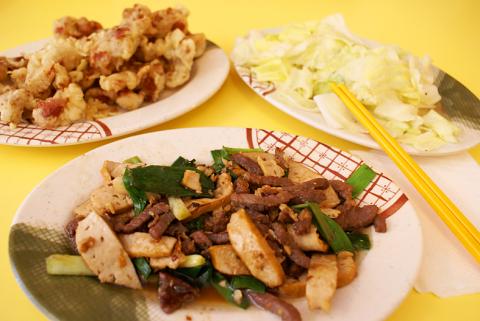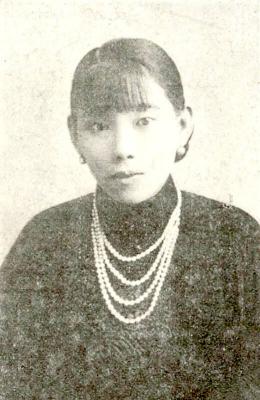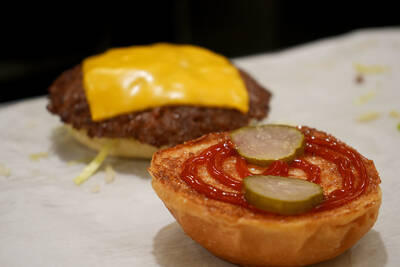“A fresh look on traditional Taiwanese rechao,” reads the Facebook page of Drunken Monkey, a recently opened restaurant five minutes by foot from Guting MRT Station’s (古亭捷運站) Exit 2.
Rechao (熱炒, literally hot-fry) restaurants are a common sight across Taiwan, serving up smallish dishes of everything from deep-fried seafood, stir-fried beef and pork to vegetable and tofu dishes — all of which are typically washed down with copious Taiwan Beer. But perhaps more than anything else, rechao is about community, getting together with friends, family or colleagues and sharing several dishes and a few laughs.
Drunken Monkey’s “fresh” take on rechao is Cantonese fusion.

Photo: Noah Buchan, Taipei Times
Alex Holliday, Drunken Monkey’s talkative proprietor, learned to cook Cantonese-style food from his grandfather, who escaped the ravages of China’s Civil War and ended up in Vancouver, where he opened Capilano Heights Chinese Restaurant 37 years ago. Holliday first came to Taiwan in 2003 to learn Mandarin. He moved here in September of last year and opened the restaurant in November.
Drunken Monkey’s menu includes typical rechao fare — kungpao chicken (NT$100), fried clams with basil (NT$100), deep-fried oysters (NT$120) and deep-fried prawns with pineapple (NT$120) — as well as some “drunken munchies” — Western-style additions such as chicken nuggets (NT$100) and onion rings (NT$100).
I wanted to taste Holliday’s Cantonese favorites, and started off with the combat pork (NT$100), strips of pork dipped in batter, fried until crispy and topped with heaps of chopped garlic. Savory, crispy and garlicky, the robust combination went well with an order of slightly sweet fried cabbage (NT$80).

Photo: Noah Buchan, Taipei Times
The explosive green onion, tofu and beef (NT$100) is a dish also worth ordering, both because of its tasty combination of ingredients as well as its light seasoning. But the green onion and tofu (NT$100) is the standout dish of the items that I tried. Large chunks of lightly seared tofu are drowned in a robust Cantonese-style stew. I’ve tried this dish at other restaurants, many charging double the price for similar sized portions, and this version wins hands down. It went well with a large bottle of Taiwan Gold Label beer (NT$80) and complimentary bowl of white rice.
While many of Drunken Monkey’s dishes offer a new twist on Taiwanese culinary standards, the decor has an old-style and homey rechao feel to it: black-and-white pictures of Capilano Heights Chinese Restaurant, stools and unadorned tables in buttery yellow, walls scribbled with customer comments and framed pictures showing scenes from Chinese mythology. There is even a small table at the front reserved for bottles of whisky, kaoliang and bourbon, which customers can “keep” at the restaurant. But even the interior has some interesting additions: boxing gear (Holliday hung up his muay Thai gloves to open the restaurant) hangs off large posters of monkeys in all manner of martial arts display. A Canadian flag adorns another wall, its maple leaf replaced by a marijuana leaf.
Though Drunken Monkey is no-frills, its inexpensive and tasty fare makes it worth a visit. And if you are like me and want to have at extra few beers on the weekend, Holliday says he’ll stay open until the last “drunken monkey” staggers out of the restaurant.

Many people noticed the flood of pro-China propaganda across a number of venues in recent weeks that looks like a coordinated assault on US Taiwan policy. It does look like an effort intended to influence the US before the meeting between US President Donald Trump and Chinese dictator Xi Jinping (習近平) over the weekend. Jennifer Kavanagh’s piece in the New York Times in September appears to be the opening strike of the current campaign. She followed up last week in the Lowy Interpreter, blaming the US for causing the PRC to escalate in the Philippines and Taiwan, saying that as

Nov. 3 to Nov. 9 In 1925, 18-year-old Huang Chin-chuan (黃金川) penned the following words: “When will the day of women’s equal rights arrive, so that my talents won’t drift away in the eastern stream?” These were the closing lines to her poem “Female Student” (女學生), which expressed her unwillingness to be confined to traditional female roles and her desire to study and explore the world. Born to a wealthy family on Nov. 5, 1907, Huang was able to study in Japan — a rare privilege for women in her time — and even made a name for herself in the

This year’s Miss Universe in Thailand has been marred by ugly drama, with allegations of an insult to a beauty queen’s intellect, a walkout by pageant contestants and a tearful tantrum by the host. More than 120 women from across the world have gathered in Thailand, vying to be crowned Miss Universe in a contest considered one of the “big four” of global beauty pageants. But the runup has been dominated by the off-stage antics of the coiffed contestants and their Thai hosts, escalating into a feminist firestorm drawing the attention of Mexico’s president. On Tuesday, Mexican delegate Fatima Bosch staged a

Taiwan can often feel woefully behind on global trends, from fashion to food, and influences can sometimes feel like the last on the metaphorical bandwagon. In the West, suddenly every burger is being smashed and honey has become “hot” and we’re all drinking orange wine. But it took a good while for a smash burger in Taipei to come across my radar. For the uninitiated, a smash burger is, well, a normal burger patty but smashed flat. Originally, I didn’t understand. Surely the best part of a burger is the thick patty with all the juiciness of the beef, the